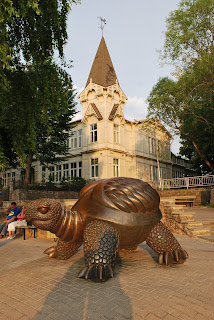 |
| Ulla napping in the Parc de Bruxelles during our layover |
I arrived in Latvia last Tuesday. Ulla and I flew from
Newark to Brussels with Jet Airways (an Indian airline: vegetarian curry &
naan for inflight meal, wide selection of Bollywood movies available, courteous
flight attendants), somnambulated our way through a 12-hour layover there, and
then took AirBaltic (Latvian flag carrier), arriving at Riga’s tiny airport
sometime around midnight. We had champagne with Ulla’s mother and her husband,
a Frenchman named Herve, until around 2am, still very tired
 |
| Ulla's friends welcomed us at the airport with these balloons |
I felt a little nervous boarding the plane in Brussels.
Everyone else on the flight was speaking Latvian, which is completely bereft of
cognates or any familiar elements, and it gave me the feeling of travelling somewhere unheard of, to the back of beyond. Actually there was one black lady from the
U.S. on the flight, but it turned out she was heading to Riga for an
international convention of Jehovah’s Witnesses. Mid-flight, I could still see by the late-night
sun the flatness of the coastline below, and by the time we approached Riga, it
was dark and there didn't seem to be any lights below the plane in the place where Ulla said Jurmala was.
Ulla’s mother, Dagmara, explained on the first of several
driving tours that neighborhoods in Latvia do not generally contain only people
of the same or similar class and/or income level, as in the United States. That
is, you find big nouveau riche houses with columns and fountains next door to
lots holding farmhouses with maybe a tumbledown shed. The neighborhood of
Jurmala where I’m staying, Vaivari, has unpaved roads running perpendicular to
the beach (parallel are paved). During the summer’s day, old women quietly tend
vegetable patches in many yards. Every house has a fence or wall surrounding
its property, which Ulla says is in lieu of and much preferable to the American-style gun-owning way, and many of
these fences have a small placard with the image of a Doberman head,
bearing the words “Nikns Suns” or
“vicious/angry dog.” There’s a dog-training school next door to the house where
I'm living (Herve has dubbed the house “domicile amour”) where many of these nikns dogs come on Saturday mornings. The domicile’s back yard backs up to some train
tracks, where the Pasažieru Vilciens, the commuter train running through Jurmala to Riga Central
Station passes several times an hour until after midnight. As a kid travelling
often by train in Europe with my family, often with my face pressed against the window, I recall thinking & wondering a lot about the lives of the
people whose houses and yards lined the tracks in places I'd never stop. It’s exciting now to be on the other side of
this equation, watching from a balcony the people in the illuminated train car go by at night.
 |
| Vaivari Station |
 |
| Forest sauvage |
 |
| The house from across the tracks |
 |
| A common sight: the train passing by the backyard |
Jurmala is essentially Riga’s beach. Long, narrow, like a
sausage hugging the coast, it’s about 25 km from Riga. Jurmala means something
akin to “seaside” in Latvian; it’s famed for its distinctive colorful wooden
building style, which to me looks sort of Victorian with more color and a
Scandinavian-Russian hybrid sensibility. The town is plenty popular with Russian
tourists, and in Majori, the central district, Russian is the primary language heard
on the streets. In years past, Brezhnev & Khruschchev were among these tourists.
 |
| Beach at Majori |

 |
| Jomas iela - Majori's main drag |
The names of the string of formerly separate fishing villages which comprise modern Jurmala are preserved in the train station names along the Riga route; names sounding vaguely like star clusters in some pop science fiction galaxy: Asari, Bulduri, Dubulti, Dzintari, etc. One of the most striking things is how little developed the beach is. Popular spas, hotels and restaurants in Majori are two or three blocks off the beach, and there are few high-rises. There is a beautiful strip of mossy coastal forest covering the dunes before the beach, with trails for walking, running, and Nordic skiing in the winter. The water is quite warm, and stays shallow for quite a long ways out. You can walk between submerged sand bars til very far out, and the underwater sand is finely ridged like the roof of a mouth. Between the fairy tale architecture, the dark & light forests, the long, bright beach, the daylight persisting until 10 or 11 o'clock, and the spirit of the local Latvians & tourist Russians celebrating their short summer to the max, Jurmala (in summer at least) is a "magic" place not quite like anywhere I've been before.
On my first solitary walk around the neighborhood I stumbled across and photographed Ulla's grandmother's house without realizing what I was looking at (it turns out her grandmother lives two houses down, and her father just a couple streets on the other side of the tracks). Apparently the wall, and the house itself, is a local curiosity and known around the neighborhood as "the artist's house" (Ulla's grandparents were artists). The house is verging on dilapidated, but has some nice stained glass windows.
In the next post, I'm sure I'll talk about Ligo/Jani, the Latvian midsummer solstice celebration, about mosquitoes, white nights, the food, and Riga.
 |
| The wall of Ulla's grandmother's house - she built this! |










